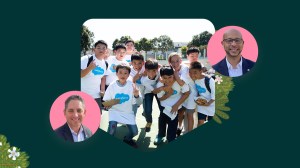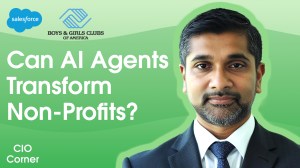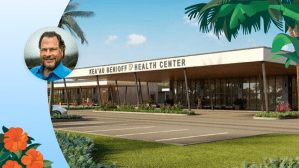Pandemic aftershocks are impacting classrooms in every corner of the world. San Francisco Unified School District (SFUSD) classrooms are among them.
Home to over 50,000 public school students in the Bay Area, and with a diverse set of backgrounds and learning needs, SFUSD and its nearly 10,000 employees are showing incredible resilience after a challenging few years.
For the past decade, Salesforce has provided significant support to SFUSD, helping improve student outcomes and opportunities. I sat down with Dr. Matt Wayne, SFUSD’s recently appointed superintendent, to hear his perspective on the impact and what it will mean for the current school year.
Q: What are the greatest needs you see as SFUSD starts a new school year?
I began serving as Superintendent of SFUSD in July, and it has been so encouraging to engage with people in San Francisco who really care for our students and our district, and want to see us succeed.
I know that many of the challenges we’re facing have existed for years. In my experience, solutions often come from building effective systems and ensuring sound implementation.
That’s why my goals for these first few months are simple: to listen and take action on the district’s most urgent and important issues.
My intent is to understand the collective vision for our students, where we’re meeting their needs, where we’re falling short, and the community’s ideas for how we can provide every student with the education they deserve.
Q: We know the impacts of the pandemic are still being felt in our schools. What are the biggest ripple effects you’re seeing with students in San Francisco?
We know the past two years have been some of the most challenging in education, and not just in San Francisco.
The pandemic has impacted our diverse communities in many ways — including those that exacerbate disparities — and we can see that in our classrooms as well. The equity-driven work to remove the predictability of success or failure that currently correlates with any social or cultural factor is more important now than ever.
Using data and a research-driven approach is critical for us to close the opportunity gap. To that end, I have been working with the Board of Education to improve governance practices so that we can effectively lead the District to improve student outcomes.
Q: Wellbeing is a growing focus in our education system. How are you thinking about supporting both student and teacher wellbeing this year?
For decades, San Francisco public schools have been a leader in implementing systems to support the emotional and physical wellbeing of students. SFUSD has a long history of offering social emotional support in our schools through social workers and nurses. The Centers for Disease Control recently featured SFUSD’s leading role in school-based wellness efforts, including our recent pandemic response.
In addition, each SFUSD high school is equipped with a Wellness Center as part of a groundbreaking program dedicated to improving the health, wellbeing, and academic success of public high school students. This program, the San Francisco Wellness Initiative, is the only school-based program for adolescent health and wellness of its kind. In recent years, and especially during the pandemic, SFUSD has focused on expanding wellness support to younger students.
Q: Salesforce has partnered with San Francisco schools for more than 10 years now. What impact has that partnership made?
The partnership has proven to be an enormous benefit to literally tens of thousands of students, not to mention a stable presence and resource over an incredibly tumultuous period.
When Salesforce launched this partnership with SFUSD and Mayor Ed Lee, it coincided with the creation of Vision 2025, SFUSD’s roadmap for providing the education and skills needed in order for students to thrive in our current world. This very much aligned with the spirit of the Salesforce grant, which included preparing students to graduate ready for college or to enter the workforce.
Q: What are some of the specific outcomes of that impact?
The Salesforce grant has focused on strengthening critical areas and creating programs that build 21st Century skills. This includes:
- Creating the nation’s first PreK-12 Computer Science curriculum, which has effectively tripled the number of students who ultimately take AP computer science (with demographics that reflect the racial and demographic makeup of SFUSD).
- Building the technical infrastructure that was needed for every middle grade school (providing wifi, purchasing devices and software) that has now enabled instruction and technology use for 17,000 middle schoolers each year for a decade.
- Training science and math teachers in common core, and the effective use of technology, to augment instruction. This enables us to accelerate teaching and learning, lower algebra repeaters from 41% to 8%, increasing the number of African American and LatinX students who take advanced math courses, and raising math proficiency for middle school to over 50% for the first time.
- Investing in teacher training programs and teacher residency programs, enabling SFUSD to recruit and deploy hundreds of qualified teachers into the classroom (during a period when teacher recruitment has become a matter of national urgency).
- Providing direct support for remote learning throughout the COVID crisis by allowing SFUSD immediate flexibility with our grant funds. This allowed the district to quickly purchase chromebooks, software and WiFi hotspots to provide families with the resources needed to quickly shift into remote learning.
More information:
- Read more about Salesforce’s commitment to education.
- Explore Salesforce’s giving history in the article Salesforce Hits Half a Billion Dollars in All-Time Giving.



















